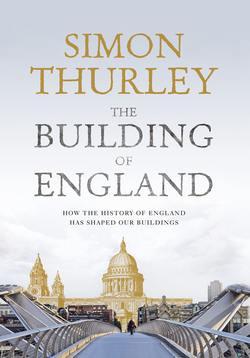Читать книгу The Building of England: How the History of England Has Shaped Our Buildings - Simon Thurley - Страница 25
The Establishment of Castles
ОглавлениеWilliam the Conqueror died knowing that the military conquest of England was complete and that a matrix of royal castles secured his power in its county towns. There were remarkably few new castles built during the following century; royal architectural attention had turned to Normandy, where the military imperative now lay. In England many castles, such as Canterbury, remained nominally in royal hands but in practice were under the control of constables or sheriffs. One still in royal hands was Norwich, newly elevated to the capital of a diocese.
Fig. 55 Norwich Castle Keep, though extensively repaired and restored by Anthony Salvin in 1835–9 its external elevations still exude the flamboyance and excess of the years around 1100.
Norwich, as we have seen, was England’s second town (p. 77), and the construction of a palatial tower there by William Rufus is a parallel to the White Tower in London. But the Norwich tower was more audacious. It was sited on a high artificial mound or motte, linked to an outer bailey by a giant arched bridge. The same masons worked on the tower and on the cathedral, and the architectural exuberance of Rufus’s reign is apparent in both. Although the tower has been refaced, a series of watercolours of 1796 shows a building without corner turrets, but with massive buttresses framing an intricately composed decorative façade. Inside, the plan centred on a great ceremonial hall lit by high windows.26
These towers were very much a feature of the first generation of Norman overlords. There is scant evidence that the White Tower was ever used as a regular residence, and many, such as Norwich, had long interruptions in their construction. Others, such as Colchester, remained unfinished. The vastness of these structures, conceived in a militarised society for feasting, security and image, was becoming unnecessary as quickly as they were built. But the image of power they were able to convey remained a desirable and fashionable accessory for more than a century to come (p. 102). Two of Henry I’s courtiers demonstrate the allure of the great tower. In the 1120s Geoffrey de Clinton, chamberlain and treasurer to Henry I, was granted lands in Warwickshire, where he founded a castle and priory. The castle at Kenilworth was hugely ambitious and was bankrolled by the king, who wanted to establish it as a royal centre of power against the nearby Earl of Warwick, who was of doubtful loyalty. A great tower was erected and an inner courtyard enclosed around it by a wall. At Portchester, Hampshire, another Norman magnate, Hugh Pont de l’Arche, replaced the Saxon residential buildings inside the Roman walls in the 1130s with a square-plan great tower with a hall at first-floor level.27
